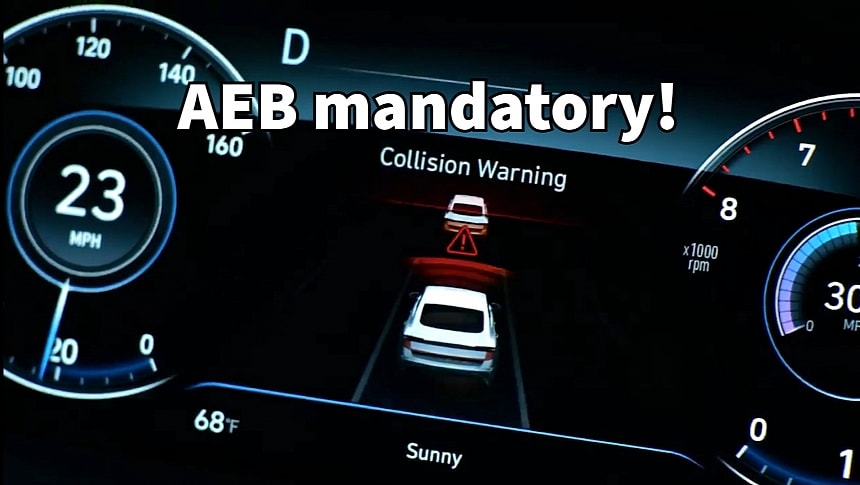The NHTSA finalized a rule that requires automatic emergency braking systems to be installed on all new passenger vehicles and light trucks sold in the US by 2029. The new rule is estimated to save over 360 lives and prevent 24,000 injuries every year.
The National Highway Traffic Safety Administration (NHTSA) has been working on regulations that would see automatic emergency braking (AEB) systems becoming mandatory on passengers vehicles and light truck sold in the US. The NHTSA announced the initiative last year when it wanted cars and light trucks to be able to stop and avoid contact with a vehicle or a human in front of them up to 62 mph (100 kph). The draft proposed that the AEB systems become mandatory three years after the final form of the act is published.
That was a year ago, but now that the NHTSA has approved the final AEB regulations, the agency has allowed carmakers more time to comply. The AEB regulation will affect all passenger vehicles and light trucks sold in the US starting in 2029, five years from now. Other details from the last year's draft proposal have remained largely unchanged.
The FMVSS No. 127 regulation mandates that AEB systems apply brakes automatically at speeds up to 90 mph (145 kph) when a collision with another vehicle is imminent and 45 mph (72 kph) when the system detects a pedestrian. They should be able to avoid contact with the car in front of them up to 62 mph. Moreover, the AEB systems should be able to detect vulnerable road users during the day and at night. The new regulation is expected to prevent 362 road deaths per year and reduce the severity of 24,321 injuries.
According to the Associated Press, about 90% of new vehicles sold in the US already have automatic emergency braking systems. However, there are no performance requirements, which makes carmakers complacent. Out of 17 cars the NHTSA tested under the new requirements, only one has met them: the 2023 Toyota Corolla equipped with cameras and radar.
Similar test results were achieved by the Insurance Institute for Highway Safety (IIHS) when it assessed the crash avoidance systems installed on 10 small SUVs. The tests were done at only 43 mph (70 kph) but many cars failed to stop in time to avoid a crash. Just one vehicle, the Subaru Forester, earned a Good rating after avoiding a car ahead and slowing down for a motorcycle. The Honda CR-V was rated Acceptable because it avoided the car but struggled to brake for the motorcycle.
The NHTSA said that most vehicles could comply with the new rules with a software update. However, carmakers argued that significant hardware and software changes would be needed to avoid crashes altogether. The Alliance for Automotive Innovation, an association of automakers, urged the NHTSA to allow reductions in speed in some cases. Last year, the Alliance was sure no production vehicle would comply with the new regulations.
That was a year ago, but now that the NHTSA has approved the final AEB regulations, the agency has allowed carmakers more time to comply. The AEB regulation will affect all passenger vehicles and light trucks sold in the US starting in 2029, five years from now. Other details from the last year's draft proposal have remained largely unchanged.
The FMVSS No. 127 regulation mandates that AEB systems apply brakes automatically at speeds up to 90 mph (145 kph) when a collision with another vehicle is imminent and 45 mph (72 kph) when the system detects a pedestrian. They should be able to avoid contact with the car in front of them up to 62 mph. Moreover, the AEB systems should be able to detect vulnerable road users during the day and at night. The new regulation is expected to prevent 362 road deaths per year and reduce the severity of 24,321 injuries.
According to the Associated Press, about 90% of new vehicles sold in the US already have automatic emergency braking systems. However, there are no performance requirements, which makes carmakers complacent. Out of 17 cars the NHTSA tested under the new requirements, only one has met them: the 2023 Toyota Corolla equipped with cameras and radar.
Similar test results were achieved by the Insurance Institute for Highway Safety (IIHS) when it assessed the crash avoidance systems installed on 10 small SUVs. The tests were done at only 43 mph (70 kph) but many cars failed to stop in time to avoid a crash. Just one vehicle, the Subaru Forester, earned a Good rating after avoiding a car ahead and slowing down for a motorcycle. The Honda CR-V was rated Acceptable because it avoided the car but struggled to brake for the motorcycle.
The NHTSA said that most vehicles could comply with the new rules with a software update. However, carmakers argued that significant hardware and software changes would be needed to avoid crashes altogether. The Alliance for Automotive Innovation, an association of automakers, urged the NHTSA to allow reductions in speed in some cases. Last year, the Alliance was sure no production vehicle would comply with the new regulations.







